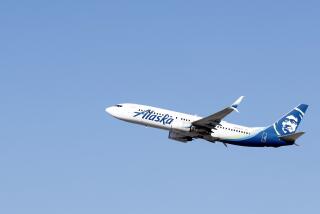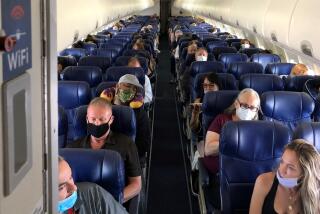Ensuring Safety in the Skies
- Share via
There is a striking disparity between the great majority of Americans, who expressed shock and disbelief that terrorists could so easily employ four passenger jets as instruments of carnage on Tuesday, and aviation security experts, many of whom said they were not at all surprised that America’s aviation safety systems could be violated.
Since 1988, when terrorists blew up a Pan Am 747 over Lockerbie, Scotland, a number of presidential commissions have recommended a host of sensible safety measures to protect America from such tragedies. The Federal Aviation Administration, however, has been shamefully slow to implement those measures.
Last year, the Government Accounting Office concluded that “the threat of terrorism against the United States is an ever-present danger” largely because the FAA and the airline industry have made so little progress in fixing “serious vulnerabilities in our aviation system.” “The chain of security protecting our aviation system,” the GAO concluded, “has not one but several weak links.”
On Wednesday, federal officials announced that they will try to strengthen that chain by banning passengers from carrying knives of any size or type onto flights and by implementing new security procedures at U.S. airports, including searches of flight crews, service personnel and vendors and a prohibition on curbside check-ins. But most aviation safety experts agree that at least five other safety steps are essential.
* Ensure that state-of-the-art electronic scanning devices capable of detecting knives, plastic explosives and other slyly concealed terrorist weapons are installed at all major U.S. airports. Most U.S. airports have yet to acquire FAA-certified high-tech devices.
* The call to make all airport security personnel federal employees no longer seems overly expensive. At the very least, the FAA should immediately implement federal standards for hiring and testing airport security workers, who Transportation Secretary Norman Y. Mineta earlier this year admitted are mostly “poorly trained ... minimum-wage workers.”
Most European nations use government screeners or require their airport security screeners to have at least 60 hours of classroom training in weapons detection and terrorist identification. They pay their screeners at least 30% more than most fast-food restaurant workers make and require that all airlines follow uniform, stringent guidelines for hiring, certifying and testing workers.
In the United States, by contrast, the FAA requires screeners to have only 12 hours of classroom training. Most private security companies pay screeners minimum wage. And responsibility for screening passengers and baggage is not coordinated by the airport or federal officials, varying from airline to airline. Restrictions are so lax that airlines are even free to hire felons.
* The FAA should fully implement the so-called computer-assisted passenger prescreening system, which helps airport security identify terrorism suspects--despite objections from some civil libertarians who view the system as an invasion of privacy because it allows security workers to look at personal information like itineraries and arrest records.
* Although it would be virtually impossible to make a plane’s cockpit invulnerable to attack, the FAA should require airlines to install stronger cockpit doors on commercial jets.
* Expand the use of FAA “sky marshals,” who fly on airliners to detect and thwart possible terrorists. Some legislators have suggested an increase in the program, which now has only a few dozen such marshals.
Federal officials have a duty to do everything they can to patch as many holes as possible in America’s tattered aviation safety net. Their failure to do so despite the sensible recommendations of scores of commissions in the 1990s was an outrage. On Tuesday it became part of an unspeakable tragedy.
More to Read
Sign up for Essential California
The most important California stories and recommendations in your inbox every morning.
You may occasionally receive promotional content from the Los Angeles Times.










